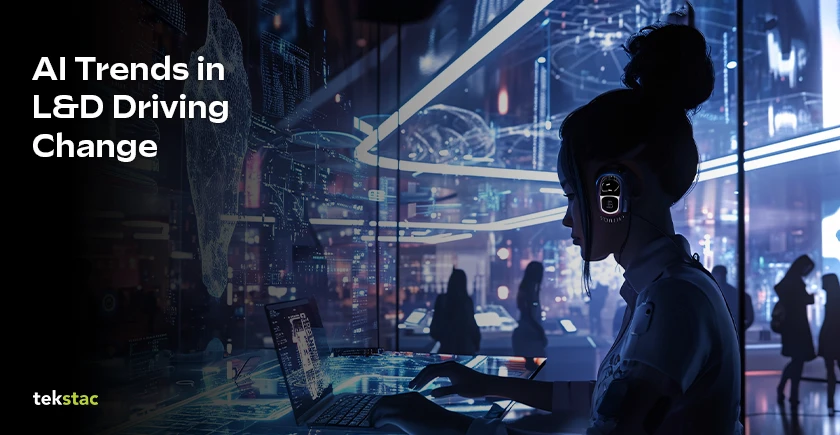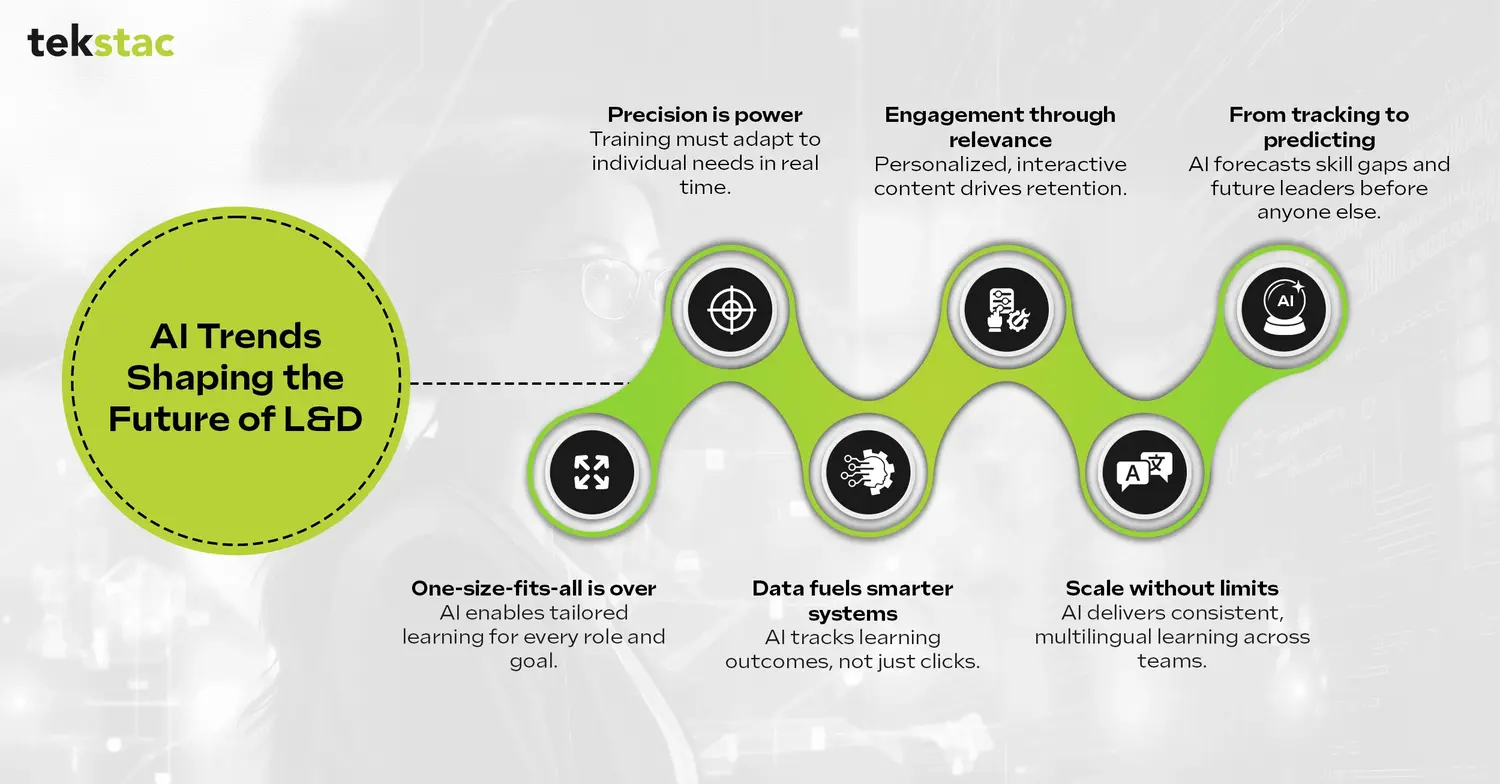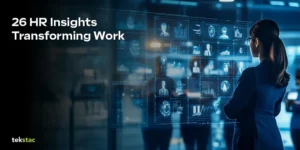Top 6 AI Trends Revolutionizing Learning & Development in 2026

In 2025, the pace of change has exploded. Emerging AI trends in L&D are redefining every aspect of workplace operations and learning. Yet, many organizations are still training like it’s 2010.
The world of Learning and Development (L&D) is at a turning point, as outdated systems clash with the urgent need for workplace upskilling with AI, and companies struggle to keep pace with the demands of digital transformation in L&D.
While AI promises hyper-personalization, real-time insights, and automation at scale, the uncomfortable truth is that most businesses are stuck delivering cookie-cutter training that satisfies no one.
The rise of AI trends in learning tech has made it clear: generic learning paths are obsolete. Workers demand training that reflects their roles, goals, and learning styles. Instead, they’re handed recycled slide decks and linear modules that neither engage nor empower.
Why AI Trends Matter for the Future of Learning & Development
AI Trends in L&D refer to the emerging ways artificial intelligence is transforming workplace learning. They include hyper-personalized learning paths, predictive analytics, adaptive content, skill intelligence, and AI-powered coaching that improve performance, retention, and training efficiency across the organization.
In an era where 9 out of 10 of executives say the skills gap is a critical business issue, clinging to traditional L&D models isn’t just inefficient. It’s a risk to survival.
This article explains the most important AI Trends of 2026 with research-backed insights.
6 AI Trends Every L&D Leader Must Know in 2026

1. The Collapse of One-Size-Fits-All Learning
Let’s start with the cold reality: most L&D systems are failing.
According to the 2025 LinkedIn Workplace Learning Report, 71% of L&D teams are only experimenting with AI, not fully leveraging AI in driving measurable outcomes.
This hesitation has consequences. When 70% of training programs fail to deliver measurable outcomes, it’s not a user problem. It’s a system problem.
Current systems offer little more than completion data. They can tell you who clicked “Next,” but not who actually learned, retained, or applied anything.
Meanwhile, over half of learners abandon online courses midway, citing poor alignment with their roles. And with automation reshaping industries, job requirements evolve faster than most training teams can respond.
The result?
Disengaged employees, wasted budgets, and unmet business goals.
2. Why Precision is No Longer a Luxury
In a world moving at the speed of light, delivering personalized training isn’t just a “nice to have” anymore. It’s mandatory. L&D systems must know more than job titles.
They need to understand learning behaviors, career goals, and real-time performance data.
In companies that have embraced it, training time has dropped, skill application has soared, and employee retention has improved.
Deloitte reports that organizations using AI in L&D have seen a 24% jump in productivity and a 28% improvement in retention. At its core, this is transformation, not just tech.
3. Smarter Systems Start with Smarter Data
Here’s what legacy systems don’t do: connect learning to business outcomes. AI-powered platforms, on the other hand, don’t just deliver content, they learn from it. They track not just engagement but impact.
Leveraging AI, modern systems can track how skills evolve over time, pinpoint where progress stalls, and identify who’s ready for a promotion—exactly what AI Trends in workplace learning are now shaping across forward-thinking organizations.
By year two of using these systems, organizations report smarter decision-making, less rework, and clearer succession planning.
By year three, AI-powered learning starts surfacing insights that no spreadsheet ever could: like which departments are overperforming, which skills correlate with project success, or where burnout is brewing.
This isn’t hypothetical.
This is happening now.
4. Engagement That Feels Like Growth, Not Obligation
People don’t hate learning.
They hate irrelevant learning.
AI fixes this by making training feel personal, and customized for each individual so they feel it’s relevant for them but not forced.
It gives instant feedback, transforms lessons into interactive stories, and builds safe simulations where employees can practice without fear of failure.
Platforms like Tekstac are already using this approach.
With adaptive learning paths, localized content, and role-based recommendations, learners don’t just consume content, they experience it.
According to PwC, 72% of learners now prefer AI-based training formats over traditional methods. It’s not just more fun. It works.
5. Scale Without Compromise
Traditional L&D hits a ceiling fast. More people means more facilitators, more costs, more logistics. But with AI, scaling is seamless.
Whether you’re training 10 or 10,000, the experience remains consistent and high-quality.
Deloitte found that companies using AI for training cut costs by 35%, while simultaneously increasing reach and effectiveness.
Multilingual support, auto-translation, and real-time content adaptation mean global teams can access the same content, tailored to their needs and context.
This levels the playing field and ensures inclusivity, a critical but often neglected component of enterprise learning strategies.
6. From Tracking to Predicting: The Real ROI of AI in L&D
It’s no longer enough to ask whether someone completed a course.
The real question is: did it make a difference?
With AI, you no longer have to guess. You can see skill proficiency rising, time-to-productivity falling, and internal promotions accelerating.
One study by the Brandon Hall Group revealed that AI-based learning led to 42% higher retention and 55% faster skill acquisition.
In forward-thinking companies, L&D leaders don’t chase KPIs, they shape them.
Predictive dashboards now alert managers to emerging leaders, identify team-level skill gaps, and recommend training before performance dips.
It marks a shift from learning to strategic talent development.
AI Trends in L&D are not just about better tools — they are redefining how organizations measure productivity, skill growth, and talent readiness.
How Tekstac Powers AI Trends in Learning & Workforce Transformation
At the center of this transformation is Tekstac.
It’s not just another learning platform, it’s a complete AI-driven learning intelligence system.
Built for scale, flexibility, and performance, Tekstac integrates content creation, real-time analytics, and adaptive delivery into one seamless experience.
From SHRM-aligned learning paths to auto-generated content and knowledge checks, Tekstac personalized every aspect of training.
It identifies where each learner stands, maps growth paths, and shows HR and leadership where the talent pipeline is headed. It connects every learning act to a real business outcome, be it faster onboarding, increased internal mobility, or improved customer results.
And the impact is measurable. Companies using Tekstac report up to 48% reduction in learning cycle time and 65% improvement in content relevance for high-skill roles like software development.
Whether you’re a tech giant, a healthcare provider, or a logistics firm, Tekstac adapts to your needs, your teams, and your goals.
Final Word: AI Trends Are Turning L&D Into a Revenue Engine
The companies winning in 2026 are those who stopped viewing training as a checkbox and started seeing it as a growth engine.
They moved from one-size-fits-all to one-path-for-each. From passive completion to active transformation. And from static dashboards to living, predictive maps of workforce capability.
So here’s the truth: if your training platform can’t personalize, can’t scale, and can’t connect to business outcomes, it’s not slowing you down, it’s keeping you behind.
The shift to AI-powered learning isn’t just smart.
It’s inevitable.
Make the move to a platform that sees your people not just as learners, but as your competitive edge.
A platform that doesn’t just keep up with the future, but creates it.
Tekstac isn’t the next step. It’s the leap forward.
Want to adopt AI Trends in your L&D strategy? See a live demo of Tekstac’s AI-driven learning platform in action.
FAQs on AI Trends
1. How is AI improving workplace learning outcomes?
AI boosts learning outcomes through hyper-personalized learning paths, adaptive content, and real-time feedback. Employees learn faster and retain more because training aligns with their roles and skill gaps.
2. What’s the next big thing in AI?
Skill intelligence platforms — systems that map role-based skills, predict future gaps, and auto-recommend upskilling paths. They shift L&D from delivering content to building workforce readiness.
3. What is the ROI for adopting AI in corporate training?
Organizations see higher retention, faster onboarding, and reduced training costs. AI turns L&D into a measurable business growth driver by improving productivity and workforce performance.
4. Which industries benefit from AI-driven L&D?
Industries with fast-changing skills need — tech, BFSI, healthcare, logistics, manufacturing, telecom, and retail. Any sector requiring rapid onboarding or upskilling gains from AI learning.





